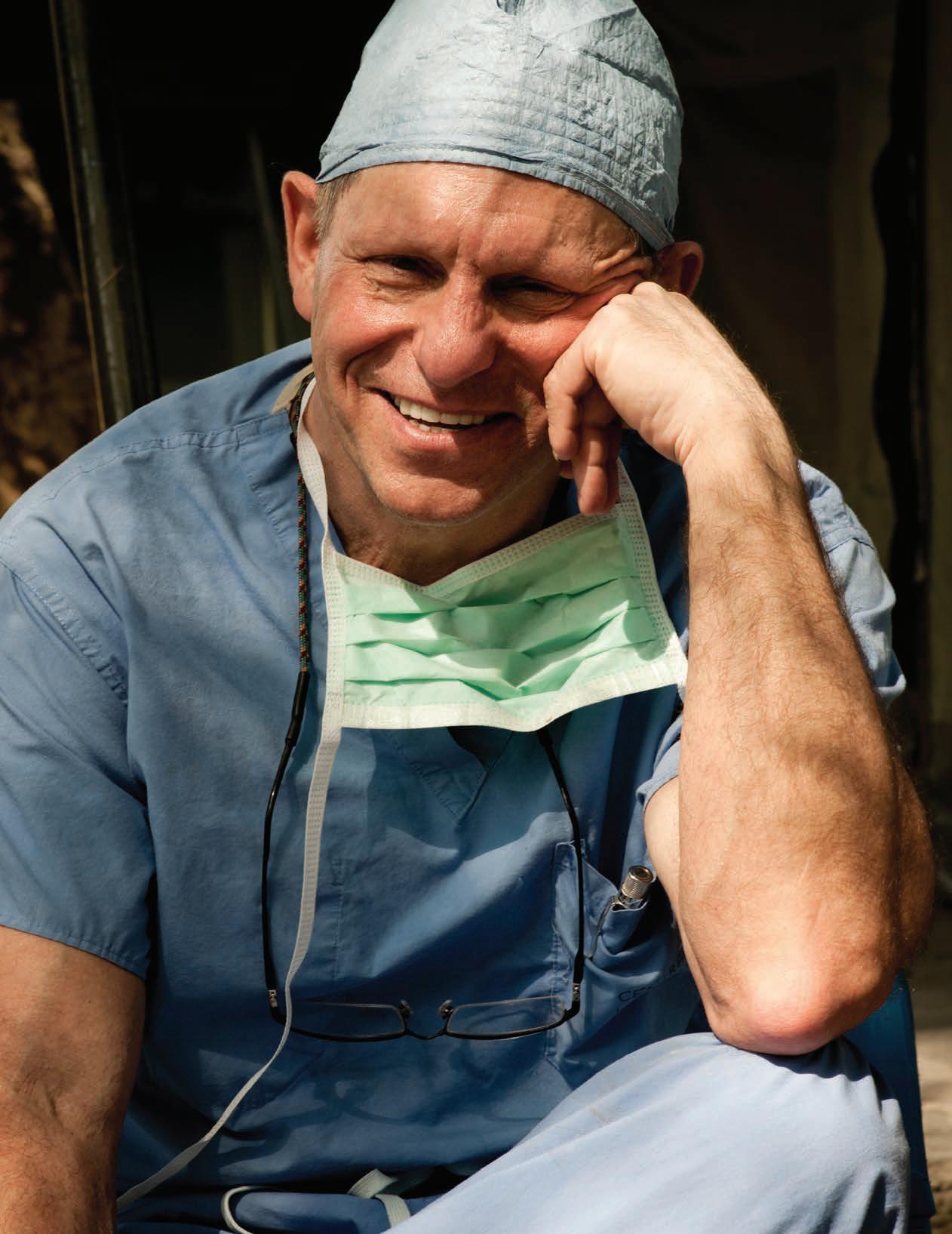
13 minute read
A Generous Life—Well Lived
Alan S. Crandall, MD
June 13, 1947 —October 2, 2020
Alan S. Crandall, MD, embodied Moran’s vision to provide hope, understanding, and treatment.
The passing of our beloved friend and extraordinary colleague, Alan S. Crandall, MD, on October 2, 2020, left all of us here at the Moran Eye Center with heavy hearts. As word spread, those feelings resonated the world over. Messages poured in from India, Ghana, Nepal, and beyond. Global outreach partners, former residents and fellows, donors, and professional ophthalmological societies offered moving tributes. Patients whose lives were changed by his brilliant surgical skills sent touching memories and deepest thanks.
We are forever grateful to all who were touched by this giant of ophthalmology and humanity and took the time to let us know.
For nearly four decades, Crandall’s ever-present enthusiasm and consideration for his colleagues shaped a culture of family at Moran. He was equally passionate about his patients’ care, teaching, and humanitarian outreach. He excelled at it all, and each aspect of his life spawned more tales than we could ever tell.
As a renowned surgeon and teacher, the professional honors he accrued were legion, but so are the personal stories. Over and over, friends and colleagues describe him as the embodiment of kindness and as a joyful spirit who made you feel you were the most important person in the world.
“Alan’s contributions to our field are absolutely immeasurable,” said Moran CEO Randall J Olson, MD. “Those he taught and influenced in deeply profound ways are numberless. He was revered as one of the greatest glaucoma, cataract, and anterior segment surgeons in our lifetime. Yet that’s not the most amazing thing about him. He was also the kindest, most humble, unassuming person you could ever hope to know.”
—ALAN S. CRANDALL, MD

Alan S. Crandall, MD, held the John E. and Marva M. Warnock Presidential Endowed Chair of Ophthalmology and Visual Sciences. He served as Moran’s senior vice chair, director of glaucoma and cataract, and senior medical director of the Global Outreach Division.
A Master Surgeon & Physician
—ALAN S. CRANDALL, MD, IN THE OPHTHALMOLOGIST

Crandall grew up in Salt Lake City in a family dedicated to community service. As the son of one of Utah’s first ophthalmologists, he recalled accompanying his father to the original St. Mark’s Hospital, where some of his father’s patients paid him on the barter system. “It wasn’t unusual to receive a chicken instead of cash,” Crandall said. “My father’s philosophy was that he would treat everybody the same way. As far as I could tell, he had no prejudice against anything other than stark stupidity. He was true to his word—he worked hard and loved what he did.”
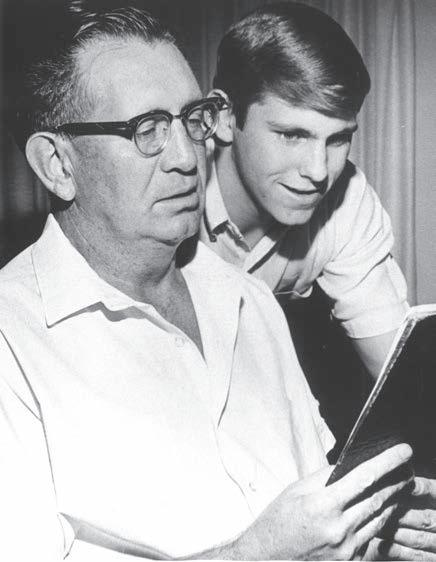
Alan Crandall with his father.
Crandall attended Salt Lake’s Judge Memorial High School, where he became a football hero despite his relatively small stature. He was also an expert skier and loved to play basketball. He received his bachelor’s and medical degrees from the University of Utah and completed a surgery internship at Pennsylvania Medical Center and residency and a glaucoma fellowship at Scheie Eye Institute in Philadelphia.
A superb surgeon who made it his mission to learn new skills, Crandall was also a remarkable innovator. Long before it became the modern standard of care, he adopted the method of phacoemulsification for removing cataracts and taught it to others.

He led the way in adopting small-incision glaucoma surgery, known as MIGS. Wielding microscopic-sized equipment to make tiny incisions, his skilled hands helped avoid countless complications in daunting situations. His success with complicated anterior segment (front of the eye) surgery is legendary.
Crandall also invented several surgical techniques and participated in numerous research studies that improved his patients’ lives. Most recently, that had included translating surgical techniques developed for adults into pediatric cases to improve outcomes.
“Alan made it a core principle that we would never be close-minded about new surgical techniques and tools, that we would always be open to what was out there,” said Olson. “And, from early on, he wanted every surgery recorded. His analysis became part of our ‘continuous quality program’ where he would take the time to sit down and review each one. He would do a root-cause analysis for each complicated case, trying to understand what may have gone wrong. He just never quit, and he shared his experience on the national and international stage.”
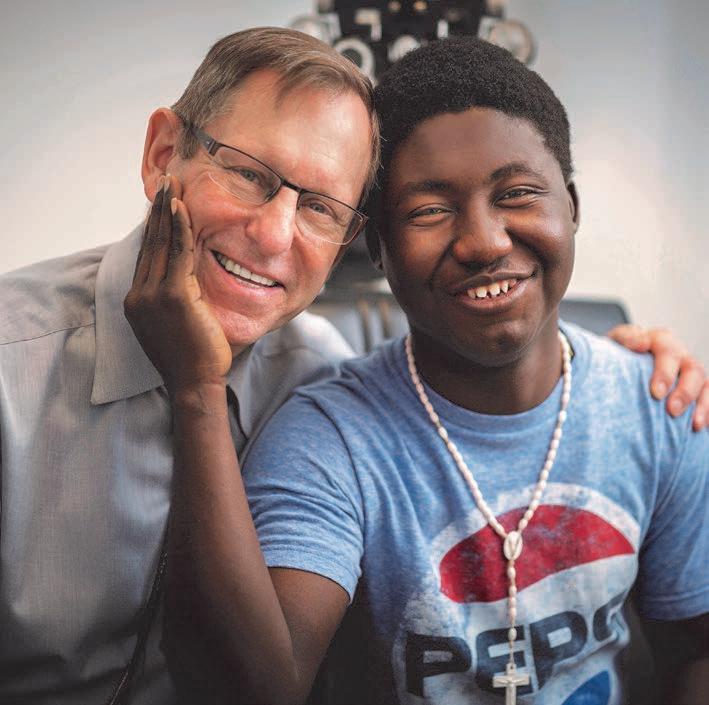
Among the many honors bestowed throughout his career, Cataract and Refractive Surgery Today named Crandall as one of 50 international opinion leaders. The Ophthalmologist recognized him as one of the 100 most influential people in the ophthalmic industry. He was a past president of the American Society of Cataract and Refractive Surgery. Crandall also served as a diplomate of the National Board of Medical Examiners and the American Board of Ophthalmology.
Boundless Compassion

While his surgical talents reached legendary status and improved the lives of thousands of patients, Crandall’s innate ability to connect with patients placed him in a category of his own.
“His connection with his patients was a thing of beauty,” said Norm Zabriskie, MD, Moran’s vice chair, medical director of clinical service, and executive director of clinical operations. “He made sure he connected with each one of them at every visit. And I don’t mean just about fishing, or food, or travel, but I mean connected in the most important way—one that said he was going to do everything he could to help them keep seeing and have the best outcome possible.”
Moran colleague Bradley J. Katz, MD, PhD, described Crandall’s unique blend of surgical and people skills: “I’ve learned so much from Alan. Not just surgery, where he’s saved my bacon more than once, but also how to be kind to patients, staff, and colleagues, giving of advice and assistance without any expectation of receiving anything in return, and helping those in need.”
Mary Elizabeth Hartnett, MD, who directs Moran’s Pediatric Retina Center, said she always thought of Crandall “whenever I performed a novel or challenging surgical procedure or task. I knew he would plug on and continue, so I could also. I will always remember his kindness, his support, and his strength and believe he would want us all to push ahead in gaining the knowledge to best serve our patients.”
Tireless Humanitarian
—ALAN S. CRANDALL, MD

The founder and senior medical director of Moran’s Global Outreach Division, Crandall began his now-legendary outreach work in Kumasi, Ghana, more than two decades ago. He traveled there in response to a request from a longtime patient who had family ties in that region. She told Crandall about the lack of ophthalmologists and the dire need for eye care, including curable blindness from cataracts, and asked him to do what he could to help. True to his nature, he said, “OK, let’s do it.”
“Alan has dedicated his career to humanitarian service, and his loving, generous spirit permeates all that he does,” said renowned cataract surgeon and American Society of Cataract and Refractive Surgery (ASCRS) Foundation Co-Chair David Chang, MD, in awarding Crandall the inaugural ASCRS Foundation Chang Humanitarian Award.

David Chang, MD, left, and Alan S. Crandall, MD, at the ASCRS Foundation Chang Humanitarian Award ceremony.
“The list of places where Dr. Crandall has given his time and skill is long and varied, including Ghana, Ethiopia, South Sudan, Nepal, India, China, Guatemala, Tonga, Haiti, Micronesia, and Cuba, as well as regular service on the Navajo Nation,” said Chang. “The nature of these outreach efforts is as impressive as the list itself.”
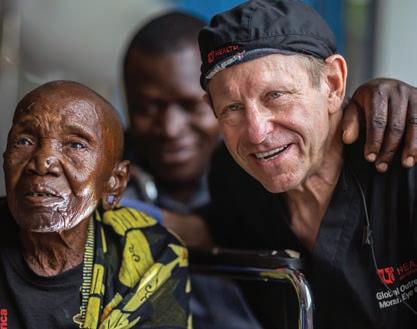
The stories of Crandall working in makeshift operating rooms around the world, often in searing temperatures, and sometimes amid an array of tropical “visitors” in the form of bugs and bats, are seemingly endless and occasionally harrowing. Whatever the story, common threads emerge.
Colleagues talk about his phenomenal stamina and enthusiasm. They recount how he always logged the highest number of procedures, hardly pausing, and never saying “no” to any challenge—whether it was continuing long past quitting time or dancing through the night. And all this despite screws in his neck, which he broke twice—the first time while skiing. The second came on a bumpy bus ride in Ghana when a 40-pound phaco machine dislodged from the luggage rack and hit the back of his neck. Later, he acquired two artificial knees and an artificial hip.

Alan and his wife Julie Crandall often volunteered together on international outreach trips.
Though he was humble, Crandall wasn’t above the “humblebrag,” but always with a smile.
He was also known for his bolo ties, which he started wearing when he figured out he was “not the bow-tie type” while on the faculty at the University of Pennsylvania in the 1970s.
Crandall was the only person to receive four internationally recognized awards in ophthalmology for his outreach work: the American Glaucoma Society Humanitarian Award, the American Academy of Ophthalmology Humanitarian Award, the ASCRS Humanitarian Award, and the inaugural ASCRS Foundation Chang Humanitarian Award.
“Alan Crandall was not only a world-famous cataract and glaucoma surgeon but a great humanitarian,” said R. Venketesh, chief medical officer of Aravind Eye Hospital in Pondicherry, India. “He is truly an inspirational human and physician. For many of us at Aravind, he was a great friend, philosopher, and guide. He strongly believed that training doctors in resource-poor countries is the main solution for eradicating needless blindness.”
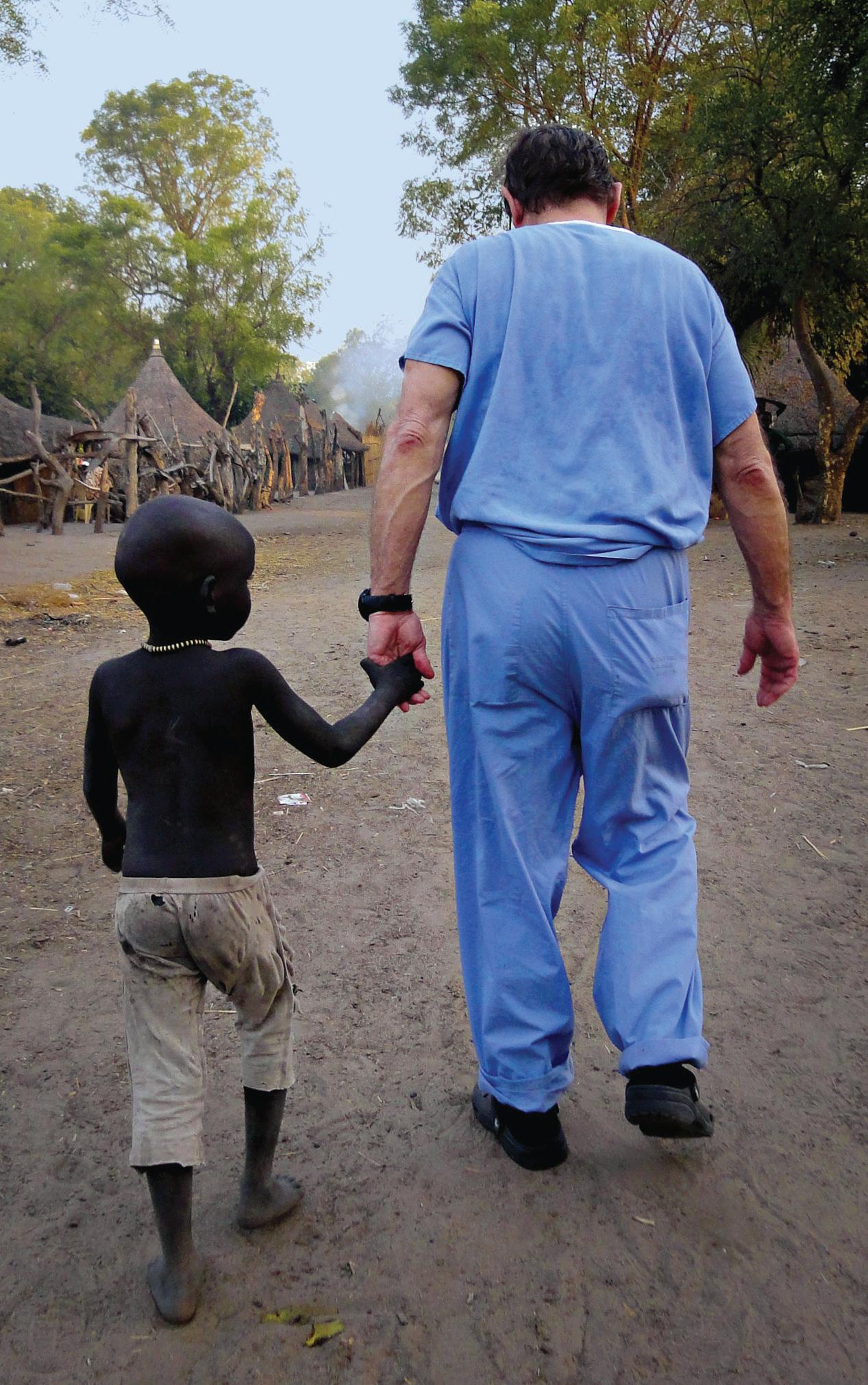
Lifelong Teacher
—ALAN S. CRANDALL, MD, TRADEMARK PHRASES TO RESIDENTS IN TRAINING

An exacting teacher and mentor, Crandall aimed to produce the finest surgeons possible. He took special pride in seeing his students excel and become leaders in the field.
“To watch his quiet hands performing surgeries was to see a master at work. If I see a surgical video anywhere in the world, I can tell if it’s someone who trained with Alan because of a few subtle things he taught,” said Jeff Pettey, MD, MBA, Moran’s vice chair of education.
John Berdahl, MD, of Vance Thompson Vision in Sioux Falls, North Dakota, and a Moran adjunct volunteer ophthalmologist, first learned of Crandall during residency at Duke University. He had heard of Crandall’s legendary skills—and that he had a reputation of sometimes intimidating his residents and fellows.
“But I know he also made his Utah residents bulletproof,” he said. “Instead of feeling intimidated when I met him, I found he had a unique ability to inspire from afar and pull out the absolute best from those he was close to. His residents, including my colleague, Russell Swan, MD, a former Moran resident and current Moran adjunct volunteer, knew his admonitions came from a place of love and enabled them to hone skills they would carry with them for a lifetime.”

Colleagues worldwide praised Crandall’s way of clearly explaining complex surgical topics in ways that even non-surgical ophthalmologists could understand. Whenever physicians, technicians, or staff around him had questions or needed assistance, he stepped up to help.
“He understood that giving someone the confidence to handle challenging cases was just as important as training their hands to produce the proper movements,” said Roger Furlong, MD, Moran adjunct volunteer ophthalmologist and glaucoma specialist in Butte, Montana. “He understood that being a good physician meant more than knowledge or technical skill.”
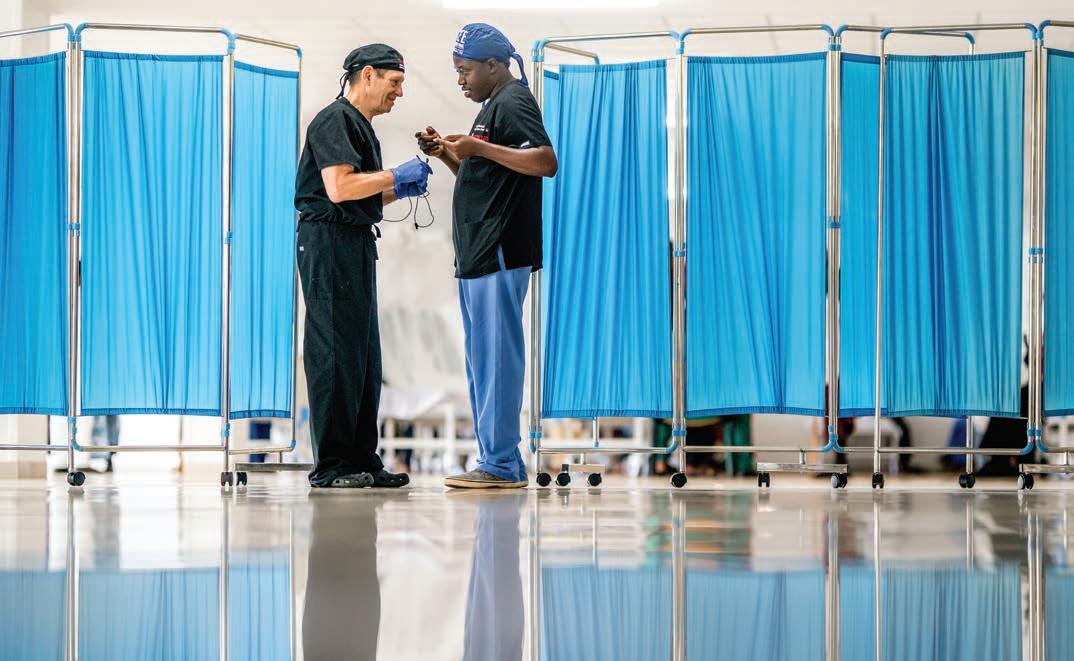
Said Moran colleague Nick Mamalis, MD, who traveled the world with Crandall: “What I think is important about Alan is that he has not only done a tremendous amount of work internationally performing cataract surgeries, but also was involved in teaching others in the developing world and creating mechanisms to show other surgeons how to do these procedures and perform them elsewhere.
“It is one thing to fly in and fly out of remote locations, but it is another to set up the mechanisms to educate medical teams. It’s like the adage: Give a man a fish and you feed him for a day. Teach a man to fish and you feed him for a lifetime.”
HUMANITARIAN AWARD HONOR
David Chang, MD, and the American Society of Cataract and Refractive Surgery Foundation in 2020 renamed their humanitarian award to bear Crandall’s name in honor of his exemplary life and commitment to charitable service: the 2021 Chang-Crandall Humanitarian Award.
MORE PHOTO AND VIDEO TRIBUTES ONLINE
bit.ly/AlanCrandall
REMEMBERING DR. CRANDALL
— Iqbal “Ike” Ahmed, MD, FRCSC, Kensington Eye Institute, University of Toronto, and former Moran fellow
—Robert Cionni, MD, Eye Institute of Utah
—Abba Hydara, former ophthalmic trainee now a glaucoma specialist and health care leader in Gambia
—Erin Merrill Kirby, patient
—Glenn Clapp, patient
—Dale and Chris McMillan, patients
—Taylor Cline, patient
—Geoff Tabin, MD, co-founder, Himalayan Cataract Project
—Susan MacDonald, MD, associate clinical professor, Tufts University School of Medicine; president, EyeCorps
— Robert Osher, MD, director emeritus of the Cincinnati Eye Institute









